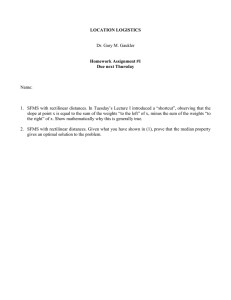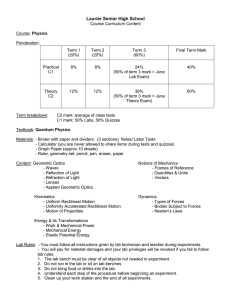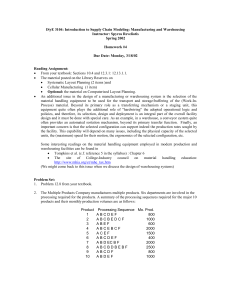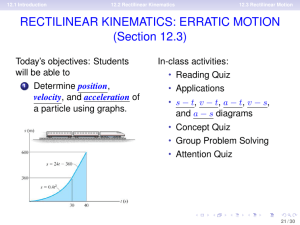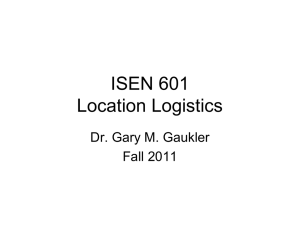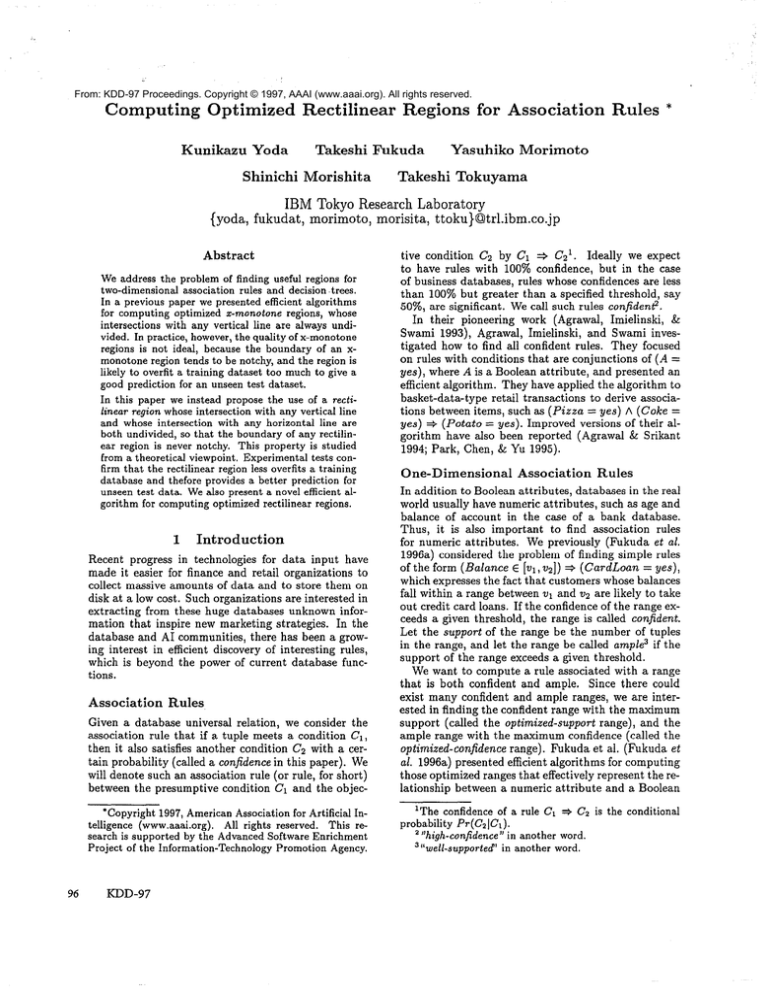
From: KDD-97 Proceedings. Copyright © 1997, AAAI (www.aaai.org). All rights reserved.
Computing
Optimized
Kunikazu
Yoda
Shinichi
Rectilinear
Takeshi
Morishita
Regions
F’ukuda
Takeshi
for Association
Yasuhiko
Rules
*
Morimoto
Tokuyama
IBM Tokyo Research Laboratory
{yoda, fukudat, morimoto, morisita, ttoku}@trl.ibm.co.jp
Abstract
We address the problem of finding useful regions for
two-dimensional
association rules and decision ,trees.
In a previous paper we presented efficient algorithms
for computing optimized x-monotone regions, whose
intersections
with any vertical line are always undivided. In practice, however, the quality of x-monotone
regions is not ideal, because the boundary of an xmonotone region tends to be notchy, and the region is
likely to overfit a training dataset too much to give a
good prediction for an unseen test dataset.
T” +l.:,
-*..-” ..r.3
:,,+,,.A p’
_..^..
a”,, +t.,
,.c 0,
., mn”,d
11‘
u111ayc4pcx
*yT I,IOLl.z~U
“p”uG
cur ..^_
UDrj “1
IGLLLlinear region whose intersection with any vertical line
and whose intersection
with any horizontal
line are
both undivided, so that the boundary of any rectilinear region is never notchy. This property is studied
from a theoretical viewpoint,
Experimental
tests confirm that the rectilinear region less overfits a training
database and thefore provides a better prediction for
unseen test data. We also present a novel efficient algorithm for computing optimized rectilinear regions.
Given a database universal relation, we consider the
association rule that if a tuple meets a condition Cl,
then it also satisfies another condition C’s with a certain probability (called a confidence in this paper). We
will denote such an association rule (or rule, for short)
between the presumptive condition Ci and the objec-
One-Dimensional
Association
Rules
In addition to Boolean attributes, databases in the real
world usually have numeric attributes, such as age and
balance of account in the case of a bank database.
Thus, it is also important to find association rules
for numeric attributes. We previously (Fukuda et al.
1996a) considered the problem of finding simple rules
of the form (Balance E [WI,~21) + (CardLoan = yes),
which expresses the fact that customers whose balances
fall within a range between wi and ~2 are likely to take
out credit card loans. If the confidence of the range exceeds a given threshold, the range is called confident.
Let the support of the range be the number of tuples
in the range, and let the range be called ample3 if the
support of the range exceeds a given threshold.
We want to compute a rule associated with a range
that is both confident and ample. Since there could
exist many confident and ample ranges, we are interested in finding the confident range with the maximum
support (called the optimized-support range), and the
ample range with the maximum confidence (called the
optimized-confidence range). Fukuda et al. (Fukuda et
al. 1996a) presented efficient algorithms for computing
those optimized ranges that effectively represent the relationship between a numeric attribute and a Boolean
*Copyright
1997, American Association for Artificial Intelligence (www.aaai.org).
All rights reserved.
This research is supported by the Advanced Software Enrichment
Project of the Information-Technology
Promotion Agency.
‘The confidence of a rule Ci =+ Cz is the conditional
probability
Pr(Cz[Ci).
’ “high-confidence”
in another word.
3”well-supported’ in another word.
1
Introduction
Recent progress in technologies for data input have
made it easier for finance and retail organizations to
collect massive amounts of data and to store them on
disk at a low cost. Such organizations are interested in
extracting
from
these huge databases
unknown
infor-
mation that inspire new marketing strategies. In the
database and AI communities, there has been a growing interest in efficient discovery of interesting rules,
which is beyond the power of current database functions.
Association
96
tive condition Cs by Ci + C’s’. Ideally we expect
to have rules with 100% confidence, but in the case
of business databases, rules whose confidences are less
than 100% but greater than a specified threshold, say
50’31, are significant. We call such rules confide&.
In their pioneering work (Agrawal, Imielinski, &
Swami 1993), Agrawal, Imielinski, and Swami investigated how to find all confident rules. They focused
on rules with conditions that are conjunctions of (A =
yes), where A is a Boolean attribute, and presented an
efficient algorithm. They have applied the algorithm to
b&k&d&a-)-type r&d! t*rangctiQgs t*Q&rive ssgciations between items, such as (Pizza = yes) A (Colce =
yes) + (Potato = yes). Improved versions of their algorithm have also been reported (Agrawal & Srikant
1994; Park, Chen, 8z Yu 1995).
KDD-97
Rules
attribute.
Two-Dimensional
Association
Rules
In the real world, binary associations between two attributes are not enough to describe the characteristics of a data set, and we therefore often want to find
a rule for more than two attributes. We previously
(Fukuda et al. 1996b) considered the problem of finding two-dimensional association rules that represent
the dependence on a pair of numeric attributes of the
probability that an objective condition (corresponding
to a Boolean attribute) will be met. For each tuple
t, let t[A] and t[B]
be its values for two numeric attributes; for example, t[A] = “Age of a customer t”
and t(B] = “Balance of t”. Then, t is mapped to a
point(~[4,t[Bl) in an Euclidean plane E2. For a region P in E2, we say that a tuple t meets the condition
“(Age, Balance) E P” if t is mapped to a point in P.
We want to find a rule of the form ((A,@ E P) =+ C
such as
((Age, Balance)
E P) =F- (Cardhan
= yes).
In practice, we must consider huge databases containing millions of tuples, and hence we have to handle millions of points, which may occupy much more
space than the available main memory. To avoid dealing with such a large number of points, we discretize
the problem; that is, we distribute the values for each
numeric attribute into N equal-sized buckets. We
divide the Euclidean plane into N x N pixels (unit
squares), and map each tuple t to the pixel containing
the point (t[A], t[B]). Let M denote the total number
of records in the given database. We expect that the
average number of records mapped to one pixel is neither too small nor too large. In practice, we assume
that m 5 N 5 m, thereby ensuring that the average number of records mapped to one pixel ranges from
1 to m.
We use a union of pixels as the region of
a two-dimensional association rule. Confident regions,
ample regions, and optimized-confidence(-support) regions can be naturally defined as in the case of onedimensional association rules.
The shape of region P is important for obtaining a
good association rule. For instance, if we gather all the
pixels whose confidence is above some threshold, and
define P to be the union of these pixels, then P is a confident region with (usually) a high support. A query
system of this type is proposed by Keim et al. (Keim,
Kriegel, & Seidl 1994). However, such a region P may
consist of many connected components, often creating
an association rule that is very difficult to characterize, and whose validity is consequently hard to see.
Therefore, in order to obtain a rule that can be stated
briefly or characterized through visualization, it is required
that
P nhnnlcl
I-__ I__ hdnnrr
----__ D tn
-- a &ss
of rq$Qns
y&h
nice geometric properties.
X-monotone
Regions
In a previous paper (Fukuda et al. 1996b), we considered two classes of geometric regions: rectangular
regions, and x-monotone regions. Apte et al. (Apte et
l--i
Figure 1: Optimized-Confidence
and Rectilinear (Right) Regions
X-monotone (Left)
al. 1995) also report the use of ranges and rectangular regions in rules for prediction. A region is called
z-monotone if its intersection with any vertical line is
undivided. Optimized x-monotone regions cannot be
computed in polynomial time of N and log M unless
P = NP; however, we gave an O(N2 log M)-time approximation algorithm (Fukuda et al. 199613).
Assuming that N 5 m,
the time complexity of
the algorithm is O(M 1ogM). We also presented an
O(N3)-time algorithm for computing the optimizedconfidence (support) rectangles.
We introduced x-monotone regions to show that various shapes of region can be represented by x-monotone
regions, and that the coniidence (support) of the
optimized-confidence (-support) x-monotone region is
much greater than that of the optimized-confidence (support) rectangle, since any rectangle is an instance
of an x-monotone region.
For various reasons, however, x-monotone regions
are not ideal. One reason is that the boundary of an
x-monotone region tends to be notchy; for instance,
Figure 1 (left) shows an instance of an optimizedconfidence x-monotone region. In Section 4, we give
details of this instance, and present a theoretical analysis of the shape of the boundary of the optimizedconfidence x-monotone region.
Another problem is that an optimized x-monotone
region is likely to overfit the training dataset seriously,
and therefore generally fails to give a good prediction
for an unseen dataset. To be more precise, even if
we create the optimized-confidence x-monotone region
from a training dataset, the confidence of the region
against an unseen dataset tends to be worse than the
original confidence against the training dataset. With
regard to this problem, we present some experimental
results in Section 5.
Main
Results
We are looking for appropriate classes of regions between two extreme classes, rectangles and x-monotone
regions; in this paper we propose the use of rectilinear
~eg207is.
A
r&
,,,,,,.+,,I
L",I,I-sL~CU
..,A,.,
rr;Fj,uu
:" ,.,11,-.,-l
lr3 Lo,Uc;U
".,,+;I;,"",
I a,G‘b‘,‘GU,
if both its intersection with any vertical line and its
intersection with any horizontal line are always undivided. From this definition, the boundary of a rectilinear region is never notchy; for instance, Figure 1
(right) shows the optimized-confidence rectilinear region generated from the same grid as that used for the
Yoda
x-monotone region in Figure 1 (left). In Section 4 we
present a theoretical analysis of this subject. Furthermore, compared with the case of x-monotone regions,
an optimized rectilinear region less overfits a training
dataset and provides a better prediction for an unseen
dataset, which is confirmed by some experiments in
Section 5.
We present O(N3 log M)-time approximation algorithms in Section 3. Assuming that N 5 a,
the
time complexity of these algorithms is O(M3i2 log M),
which is feasible in practice.
An interesting application of rectilinear regions is
decision-tree construction. Previously (Fukuda et aE.
1996c), we proposed the construction of decision trees
in which at each node, to split data effectively into two
classes, we use the x-monotone region that minimizes
Quinlan’s entropy function. It is an interesting question whether or not the use of rectilinear regions in
place of x-monotone regions might increase the classification accuracy of decision trees with region splitting,
and we will report some experimental results in a forth
comming paper (Fukuda et al. 1997).
Related
Work
Interrelation between paired numeric attributes is a
major research topic in statistics; for example, covariante and line estimators are well-known tools for representing interrelations. However, these tools only show
the interrelation in an entire data set, not in a subset of
the data in which a strong interrelation holds. Several
heuristics using geometric clustering techniques have
been introduced for this purpose (Ng & Han 1994;
Zhang, Ramakrishnan, & Linvy 1996).
Some other ,studies deal with numeric attributes
and try to derive rules. Piatetsky-Shapiro (PiatetskyShapiro 1991) investigates how to sort the values of a
numeric attribute, divide the sorted values into approximately equal-sized ranges, and use only those
fixed ranges to derive rules whose confidences are almost 100%. Other ranges except for the fixed ones
are not considered in his framework. Recently Srikant
and Agrawal (Srikant & Agrawal 1996) have improved
Piatetsky-Shapiro’s method by adding a way of combining several consecutive ranges into a single range.
The combined range could be the whole range of the
numeric attribute, which produces a trivial rule. To
avoid this, Srikant and Agrawal present an efficient
way of computing a combined range whose size is at
most a threshold given by the user. Their approach
can generate hypercubes.
Some techniques have been developed for handling
numeric attributes in the context of deriving decision
trees. ID3 (Quinlan 1986; 1993), CART (Breiman et
al. 1984), Cz>P (Agrawal, Imielinski, & Swami 1993),
.,
.x,s-l
oll‘
cl
CT 1f-l
Ul.JL.+
/M&b,
\A*rr;lLra,
A rrrn..,nl
A-L~i’avvcw,
9. T2:rclo,,,
CL AL,UU(Li,~,l
lcmLz\
AYil”,
“..l.:n”+
UU”Jrx~
a numeric attribute to a binary partitioning, called a
guillotine cut, that maximizes Quinlan’s entropy function (Quinlan 1986). To the best of our knowledge,
the idea of splitting a region to maximize the entropy
function has never been seriously exploited except by
the present authors (Fukuda et al. 1996c).
98
KDD-97
2 Two-Dimensional
Association
Rules
Pixel Regions
Definition
2.1 Let us consider two numeric attributes A and B. We distribute the values of A and B
into NA and NB equal-sized buckets, respectively. Let
us consider a two-dimensional NA x Nn pixel-grid G,
which consists of NA x NB unit squares called pixels.
G(i, j) is the (i, j)-th pixel, where i and j are called
the row nzlmber and column number, respectively. The
j-th column G(*,j) of G is its subset consisting of all
pixels whose column numbers are j. Geometrically, a
column is a vertical stripe. I
We use the notation n = NA x NB. In our typical
applications, the ranges of NA and NB are from 20
to 500, and thus n is between 400 and 250,000. For
simplicity, we assume that NA = Nn = N from now
on, although this assumption is not essential.
Definition 2.2 For a set of pixels, the union of pixels
in it forms a planar region, which we call a pixel region.
A pixel region is rectangular if it is a rectangle. A pixel
region is x-monotone if it is connected and its intersection with each column is undivided (thus, a vertical
range) or empty. A pixel region is rectilinear if it is
connected, its intersection with each column (vertical
line) is undivided or empty, and its intersection with
each row (horizontal iinej is undivided or empty. I
Optimized
Two-Dimensional
Association
Rules
The following is the formal definition of optimized twodimensional association rules.
Definition
2.3 For each tuple t, t[A] and t[B] are values of the numeric attributes A and B at t. If t[A] is
in the i-th bucket and t[B] is in the j-th bucket in the
respective bucketings, we define f(t) = G(i, j). Then,
we have a mapping f from the set of all tuples to the
grid G.
Let C denote an objective condition. A tuple t is
a success tuple if t satisfies C. For each pixel G(i,j),
ui,j is the number of tuples mapped to G(i,j), and
zti+ is the number of success tuples mapped to G(i,j).
Given a region P, the number of tuples mapped to a
pixel in P, CG(i,jjEP ui,jr is called the support of P,
or support(P). I
In this paper, the support of P denotes a number of
tuples rather than a percentage, since we do not want
to declare the base of the percentage each time.
Definition
2.4 The number of success tuples mapped
to a pixel in P, &i,jJEP~i,jr
is called the hit of P,
or hit(P).
The ratio of the number of success tuples to the number of tuples mapped to P, that is,
hit(P)/support(P),
is called the confidence of P, or
cU?kJ\A
t/D\
1.
m
I
In order to express an association rule that tuples
mapped to region P also meet condition C with a probability of canf(P), we use the following notation:
(A,B)
E P =S C,
which is called a two-dimensional association rule.
Definition 2.5 A region is called confident (resp. ample) if the confidence (the support) is at least a given
threshold. We want to find a rule associated with a region that is both confident and ample, but there could
be many such regions. An optimized-confidence region
is the ample region that maximizes confidence. An
optimized-support
re ion is the confident region that
maximizes support. ii
{hi!
Convex Hull
We have the following property similar to the csse
for x-monotone regions.
Theorem 2.1 An O(N3M) time algotithm exists for
computing the optimized-support (-confidence) rectilinear region, but no algorithm running in polynomial
time with respect to N and log M exists unless P =
NP.
Proof:
See (Yoda et al. 1997). 1
In the next section, we present an G(N3 log M)-time
approximation algorithm for computing optimizedsupport (-confidence) rectilinear regions.
3
Approximation
Algorithms
for
Optimized
Rectilinear
Regions
Hand-Probing
Technique
in this section, we briefly review the “hand-probing”
technique, which Asano et al. (Asano et al. 1996)
invented for image segmentation and Fukuda et al.
(Fukuda et al. 1996b) modified for extraction of optimized x-monotone regions. Here we also tailor the algorithm to compute the optimized rectilinear regions.
Definition
3.1 We map each rectilinear region P to
hit(P))
in an Euclidean
a stamp point (support(P),
plane. I
Since there are more than 2N rectilinear regions, we
cannot afford to generate all stamp points; instead, we
just imagine them. Consider the upper convex hull
of all of the stamp points. A stamp point, say PI
in Figure 2, associated with the optimized-confidence
(-support) rectilinear region does not always exist on
the hull. In practice, however, a huge number of points
are fairly densely scattered over the upper hull, and it
is reasonable to assume that we can find a point, say
P2 in Figure 2, on the hull that is pretty close to PI.
This convexity assumption, as we call it, motivates us
to create an approximation algorithm for computing
optimized rectilinear regions.
The next question is how to compute a point on the
upper hull. To this end, we employ the hand-probing
technique given by Asano et al. (Asano et al. 1996).
For each stamp point on the upper hull, there must
exist a line with a slope r that is tangential to the hull
at this point. This point maximizes y - 7~ for the
set of stamp points. Accordingly, the corresponding
rectilinear region P maximizes hit(P) --7 x support(P),
which is CG(i,j)EP vi,j - rui,j.
Definition 3.2 Let us cdl Vi,j -Tui,j the gain of pixel
G(i,j), and hit(P) - 7 x support(P) the gain of P,
respectively. Among all the rectilinear regions, the
Figure 2: Convexity Assumption
optimized-gain rectilinear region P maximizes the gain
OfP. I
Using the hand-probing technique, we need to scan
stamp points on the upper convex hull efficiently to
find the optimal point, and we have shown that this
can be done by using O(log M) tangent lines (Fukuda
et al. 199613).
In the next subsection, we present an O(N3)-time
algorithm for computing the optimized-gain rectilinear
region in response to a tangent line with slope 7.
Optimized-Gain
Rectilinear
Regions
Let P be a rectilinear region. Let ml and rn2 respectively denote the indices of the first and last columns.
Let s(i) and t(i) d enote the indices of the bottom and
the top pixels of the i-th column, Since P is a rectilinear region, the sequence of top pixels from left to right,
G(i, t(i)) for i = ml,. . . , mz, increases monotonically
(t(i) 5 t(j) for ml 5 i < j < m2), decreases monotonically (t(i) 2 t(j) for ml 5 i < j 5 mz), or increases
monotonically up to some column and then decreases
monotonically. Similarly, the sequence of bottom pixels, G(i,s(i)) for i = ml,. . . ,mz, increases monotonically, decreases monotonically, or decreases monotonically up to some column and then increases monotonically.
The top picture in Figure 3 illustrates the case in
which the sequence of the top pixels (the top sequence,
for short) and the sequence of the bottom pixels (the
bottom sequence, for short) increase monotonically or
decrease monotonically.
Definition 3.3 We have four types of rectilinear region. A region that gets wider from, left to right is
named W. A region that slants upward (downward,
resp.) is named U (D). A region that gets narrower
from left to right is named N. ‘1
The middle left part of Figure 3 shows the case in
which the top sequence increases monotonically up to
some coiumn and then decreases monotonicaiiy, whiie
the bottom sequence increases monotonically or decreases monotonically. We have two types of rectilinear regions: one is a combination of a W-type subrectilinear region and a D-type sub-rectilinear region,
which will be referred as a WD-type region. The other
is a combination of a U-type sub-rectilinear region and
Yoda
99
an N-type sub-rectilinear region, which will be called
a UN-type region. The middle right part of Figure 3
shows the case in which the top sequence increases or
decreases, while the bottom sequence decreases up to
some column and then decreases. We have two types
of rectilinear region: one is WU-type, and the other is
DN-type. The bottom part of Figure 3 shows the case
in which the top sequence increases up to some column and then decreases, while the bottom sequence
decreases until some column and then increases. We
have three types: WDN, WN, and WUN.
U or WU rectilinear regions whose last column is
the m-th one and whose intersection with the mth column ranges from the s-th pixel to the t-th
For
pixel.
For m = 1, fUU>Is,tl) = ih,[s,t]*
m > 1, we pre-compute maxi+ fw(m - 1, [i, t]) and
maxi<, fu(m - 1, [i, t]) for all s 5 t, which can be
doneFin O(N2) time. We have the following recurrence:
fdm - L[4 0 + h+,t]
m=i+ fu(m - 1,(40 + h+,t]
t)
m=;ls
fu(m, [s,tl) = max
fdm, [s, t - 11) + gm,t
(or h,t when s =
Next, let fD(m, [s, t]) d enote the gain of the rectilinear region that maximizes the gain among all D or
WD rectilinear regions whose last column is the mth one and whose intersection with the m-th column
ranges from the s-th pixel to the t-th pixel. For m = 1,
For m > 1, we pre-compute
fD(L
b, 4)
=
sl,[s*t]*
maxt<i fw(m - 1, hiI) and maxtsi fu(m - 1, [s, i]),
and then obtain the recurrence:
fD(m,
h+,t]
maxtlifw(m - 1,b,4) +
maxtji
f&m
- Lls,4)
+ 9m,[s,t]
is, tl) = max fo(m, 1s+ l,tl) + hs
(orhs when s = t)
Finally, let, fN(m, [s, t]) denote the gain of the rectilinear region that maximizes the gain among all rectilinear regions whose type is N, UN, DN, WDN,
WN, or WUN, whose last column is the m-th one,
and whose intersection with the m-th column ranges
from the s-th pixel and the t-th pixel. For m = 1,
:../1
JN\',
I" +l\
13,
",,
--
"
yl,js,tj.
For
m
>
1,
hn.m
,,avc
we
+ha CP.ll,....;nm
L,IT; r"rl"rr‘lig
..,
recurrence:
i
Figure 3: Rectilinear Regions
Theorem 3.1. Optimized-gain rectilinear regions can
be computed in O(N3) rime.
Proof:
Let fw(m, [s, t]) denote the gain of the rectilinear region that maximizes the gain among all Wtype rectilinear regions whose last column is the mth one and whose intersection with the m-th column
ranges from the s-th pixel to the t-th pixel. Let gi,j
denote the gain of the pixel G(i,j), which is vi,j TUQ. Before computing fw (rn: [s: t]): we pre-compute
&[s,,] gw17 which will be denoted by gm,Is,ll, for
m= 1 ,..., N and 1 < s < t 5 N. This computation
takes O(N3) time. For m = 1, fw(l,[s,i])
= gl,[s,t].
For m > 1, ifs = t, fw(m, [s,s]) = max{g,,,, fw(m1, [s, s]) + gm+}. Otherwise (s < t), the following recurrence holds:
fw(m - 1, [s, tl) + Qm,[s,t]
fw(m, [s + 1, tl) + gm,s
fw(m, [s, t]) -r max
( . fW(% [s:t - l]! + g???,t 1,
Next, let fu(m, [s,t]) denote the gain of the rectilinear region that maximizes the gain among all
100
KDD-97
fN(?
[s, t]) = max
fw(m - 1, htl)
+ gm,js,tl
fD(m
- 1, [%tl)
+ %n,[s,t]
fN(m
-
fu(m - 1,Is,4) + gd.tl
1, 1% t]) + h&t]
fN(m,
[S -
fN
is, t +
(m,
\
1, t])
11)
-
Qm,s-1
-
Qm,t+l
J
In this
fhr(rn;
[sj t]) by us~....‘ ~~~. ~,.
\
___
1.--- case.
--~.-l we- need to comoute
and fN(m, [~,t + l]), which have
[S - l,t])
been computed for longer ranges [s - 1, t] or [s, t + l].
Thus we first compute fN(m, [l, N]) = mti{fN(m
-
ing fN(%
1, [LNI)
+
%n,[l,N]>gm
l,N]b
Consequently a simp$1e dynamic programming gives
us an O(N3) time solution for computing fw(m, [s, t]),
fu(m, [s,t]), fD(m, Is, t]), and fN(m, [s, tl). for all m
and s < t. 1
4
Mathematical
Analysis
of a Model
In this section we present a model to explain the advantage of rectilinear regions over x-monotone regions.
Although the model may look very specialized and artificial, a similar situation was frequently observed in
which the optimal x-monotone regions appeared to be
strange.
Consider the sample grid G shown in Figure 4. Suppose that the support of each pixel is 1 (which means
thatthe total number of tuples in the grid is N2) and
that the confidence of each pixel is 0 or 1. We denote a
pixel whose confidence is 1 by a black box. We denote
the lower half part of the grid by R, which consists
of the rows below (and including) the N/2-th row in
Figure 4. The row index is counted from the bottom.
We fix a constant K (5 N/2), denote the region below and including the (N/2 - K)-th row by R’, and let
R” = R - R’. The grid in Figure 4 is created according
to the foiiowing ruies:
1. Each pixel in R’ has the confidence 1.
2. Each pixel in the N/2 - i-th row has the confidence
1 with a probability of (i + 1)/K, for i < K.
3. Each pixel in G - R has the confidence 1 with a
probability of l/N.
The intuition behind the above rules is that the confidence of each grid decreases gradually from lower rows
to higher in the presence of a low level of noise. Figure 4 shows an instance in which N = 20 and K = 5.
G-R
R”
R
Theorem
4.1 The expected support of Rmonolone - R
is at least a
. N, while the support of Rrects R is bounded by 2K log2 K + O(Klog N), which
is better than the x-monotone
case by a factor of
N/(v’%?log2
Proof:
K).
See (Yoda et al. 1997). l
Note that the real factor might be much larger
.,hn.m
+hnr\mt:nol
Fn,+.ev
For
instance
than the LL”“Yc;
DLLC”‘G”ILCIII
Ia.L.b”I.
Figures 5(left) and 5(right) respectively show the
optimized-confidence x-monotone region konDlone
and the optimized-confidence rectilinear region Rrecti
for the grid in Figure 4. In this particular case, where
N = 20 and K = 5, the support of Rmonotone - R is
24, and that of Rrecti - R is 2.
The reader might think that the above particular
model favors the family of rectilinear regions over that
of c-monotone regions. The advantage of rectilinear
regions can also be shown by other typical distributions. For example, if the core R’ of the region is an
axis-parallel rectangle whose horizontal width is S?(N)
and whose vertical width is smaller than that, and the
boundary region R” forms K layers whose distribution
is the same as in the above example, the same asymptotic analysis can be obtained.
However, it is difficult to give a mathematical analysis without fixing the distribution and rule. We therefore experimentally show the tolerance of rectilinear
convex regions in the next section.
R’
1
Figure 4: Sample Grid
Figure 5: Optimized-Confidence
and Rectilinear (Right) Region
5
1
X-monotone (Left)
Consider the set of all possible grids generated according to the above rules, which we call the vniverse.
The universe contains the grid in Figure 4 as an instance. Let us use 0.5N” as the minimum support
threshold. For each grid in the universe, let us consider
how to generate the optimized-confidence x-monotone
region Rmonotone and the optimized-confidence rectilinear region RTecti. Considering the way of constructing grids in the universe, we expect that the shape of
the optimized-confidence region is fairly close to that
of Ez, and hence we are interested in the support of the
set differences Rlnonotone - R and Rrecti - R. We can
prove the following result:
Experimental
Results
Overfitting
In this section, we experimentally show that an optimized x-monotone region is likely to overfit the training dataset seriously, and therefore tends to fail to give
a good prediction for an unseen dataset, while we remark that optimized rectilinear regions do not suffer
from this overfitting problem so much.
For this experiment we generate synthetic datssets
that represent typical cases in practice. Let A and B
be numeric attributes such that the domain of both A
and B is the interval ranging from -1 to 1, and let C be
an objective Boolean attribute. We generate a dataset
whose tuples are generated according to the following
procedure:
1. Generate random points that are uniformly
tributed in I-1, l] x I-1,1].
2. For each point (t[A],t[B]),
“I2 ‘rrni
[“I
dis-
we determine the value .
.- c-n
-.-.A auu cup,c c. b” L‘LT. Ua.bcmt2L.
aa
L”U”WD)
611U
^,JA
C..,l-
4
l
^
et.,.
,I..+,,-+
Let p(z,y) be a function from [-1, l] x [-I, l]
to [O,l]. Set 1 to t[C] with a probability of
p(t[A], t[B]), and set 0 to t[C] otherwise.
We use the following two functions for p(x, y):
* r,lmeaT\-,
11,.-.--/T 9,)
,, whirh
. . ..-.... is
.I the
“..I nor..-.
.Y, =~~ r\/n e,nL~\
“a-r\
ma1 distribution N(0, fij2) with respect to the distance between (z,y) and the diagonal y = z.
Yoda
101
No. of Pixels
time in second
rectangular I x-monotone I rectilinear
Table 3: Execution time of computing optimized regions
Performance
in Computing
Rectilinear
Regions
To measure the worst-case performance, we need to
produce a synthetic dataset so that we have a large
number of stamp points that are densely scattered on
the upper convex of all the stamp points (recall Figure 2). To this end, we generated the dataset as follows: we first generated random numbers uniformly
distributed in [N2, 2N2] and assigned them to ui,j, and
then we assigned 1,2,. , . , N2 to vi,j from a cell in the
lower-right corner to the central cell in clockwise rotation, like spiral stairs.
The experiments were carried out by using our prototype system, called Database SONAR (System for
Optimized Numeric Association Rules). The programs
were written in C++ and run on one node of an IBM
SP2 workstation, each node of which has a 66-MHZ
Power2 chip, 2 MB of L2 cache, and 256 MB of main
memory, running under the AIX operating system, version 4.1.
Tables 3 shows the execution times required to find
the optimized confidence regions for the rectangular,
rectilinear, and x-monotone types, respectively, with
minimum supports of 50% and for numbers of pixels
ranging from 8 x 8 to 128 x 128. These experimental tests confirmed that the computation time for each
of the optimized rectangular regions, x-monotone regions, and rectilinear regions is respectively O(nlx5),
O(n In M), and O(n’.5 In M), where n is the number
of pixels and M is the number of tuples.
References
Agrawal, R., and Srikant, R. 1994. Fast algorithms for
mining association rules. In Proceedings of the 20th VLDB
Conjerence, 487-499.
Agrawal, R.; Imielinski, T.; and Swami, A. 1993. Mining
association rules between sets of items in large databases.
In Proceedings of the ACM SIGMOD Conference on Management of Data, 207-216.
Apte,
C.; Hong,
S. J.; Prasad,
S.; and Rosen, B.
Fukuda, T.; Morimoto, Y.; Morishita, S.; and Tokuyama,
T. 1996a. Mining optimized association rules for numeric
attributes.
In Proceedings of the Fijteenth ACM SIGACTSIGMOD-SIGART
Symposium on Principles of Database
Systems, 182-191.
Fukuda, T.; Morimoto, Y.; Morishita, S.; and Tokuyama,
T. 1996b. Data mining using two-dimensional
optimized
association rules: Scheme, algorithms, and visualization.
In Proceedings of the ACM SIGMOD Conference on Management of Data, 13-23.
Fukuda, T.; Morimoto, Y.; Morishita, S.; and Tokuyama,
T. 1996c. Constructing
efficient decision trees by using
optimized association rules. In Proceedings of the ZZnd
VLDB Conference, 146-155.
Fukuda, T.; Morimoto, Y.; Morishita, S.; and Tokuyama,
T. 1997. Implementation
and evaluation of decision trees
with range and region splitting. Technical Report RTO202,
IBM Tokyo Research Laboratory.
Keim, D.; Kriegel, H.; and Seidl, T. 1994. Supporting
data mining of large database by visual feedback queries.
In PTOC. 10th Data Enginieering, 302-313.
Mehta, M.; Agrawal, R.; and Rissanen, J. 1996. Sliq: A
fast scalable classifier for data mining. In Proceedings of
the Fifth International
Conference on Extending Database
Technology.
Ng, R. T., and Han, J. 1994. Efficient and effective clustering methods for spatial data mining. In Proceedings OJ
the 20th VLDB Conference, 144-155.
Park, J. S.; Chen, M.-S.; and Yu, P. S. 1995. An effective hash-based algorithm for mining association rules. In
Proceedings of the ACM SIGMOD
ConJerence on Management of Data, 175-186.
Piatetsky-Shapiro,
G.
1991. Discovery, analysis, and
presentation
of strong rules. In Knowledge Discovery in
Databases, 229-248.
Quinlan, J. R. 1986. Induction of decision trees. Machine
Learning 1:81-106.
Quintan, J. R. 1993. C4.5: Programs for Machine Learning. Morgan Kaufmann.
Srikant, R., and Agrawal, R. 1996. Mining quantitative
association rules in large relational tables.
In Pt-oceedings of the ACM SIGMOD
Conference on Management
of Data.
Yoda, K.; Fukuda, T.; Morimoto,
Y.; Morisita, S.; and
optimized
rectilinear
Tokuyama,
T. 1997. Computing
regions for association rules. Technical Report RTO201,
IBM Tokyo Research Laboratory.
Zhang, T.; Ramakrishnan,
R.; and Linvy, M.
1996.
Birch: An efficient data clustering method for very large
databases. In Proceedings of the ACM SIGMOD ConJerence on Management of Data, 103-114.
1995.
Ramp: Rules abstraction for modeling and prediction.
Technical Report RC-20271, IBM Watson Research Center.
Asano, T.; Chen, D.; Katoh, N.; and Tokuyama, T. 1996.
Polynomial-time
solutions to image segmentations.
In
Proc. 7th ACM-SIAM
Symposium on Discrete Algorithms,
104-113.
Breiman,
L.; Friedman,
J. H.; Olshen, R. A.; and
Stone, C. J. 1984. Class$cation
and Regression nees.
Wadsworth.
Yoda
103

